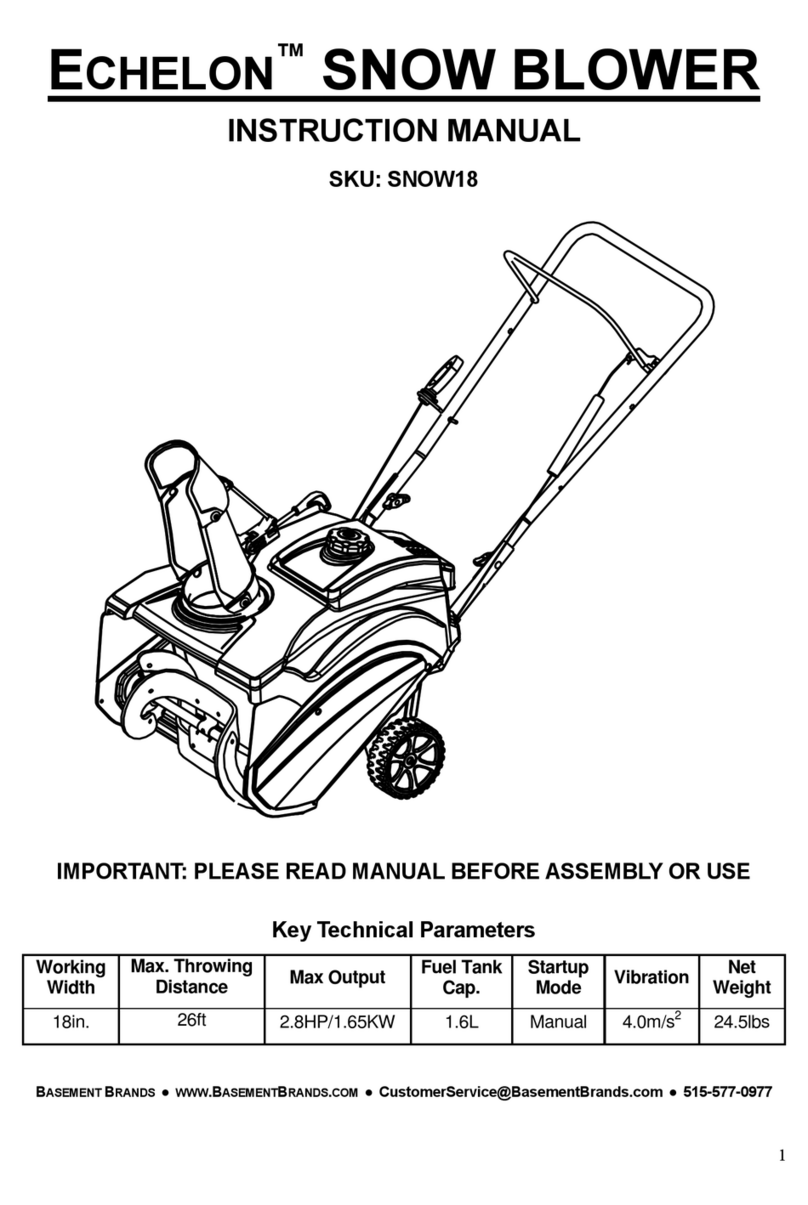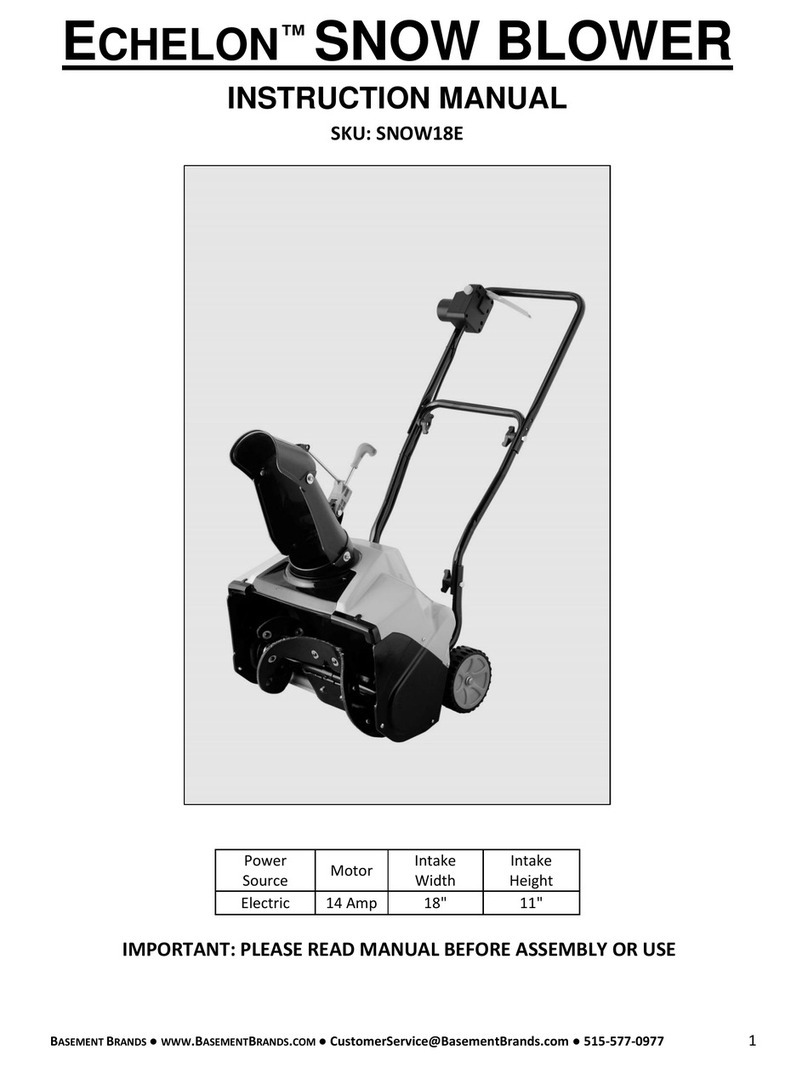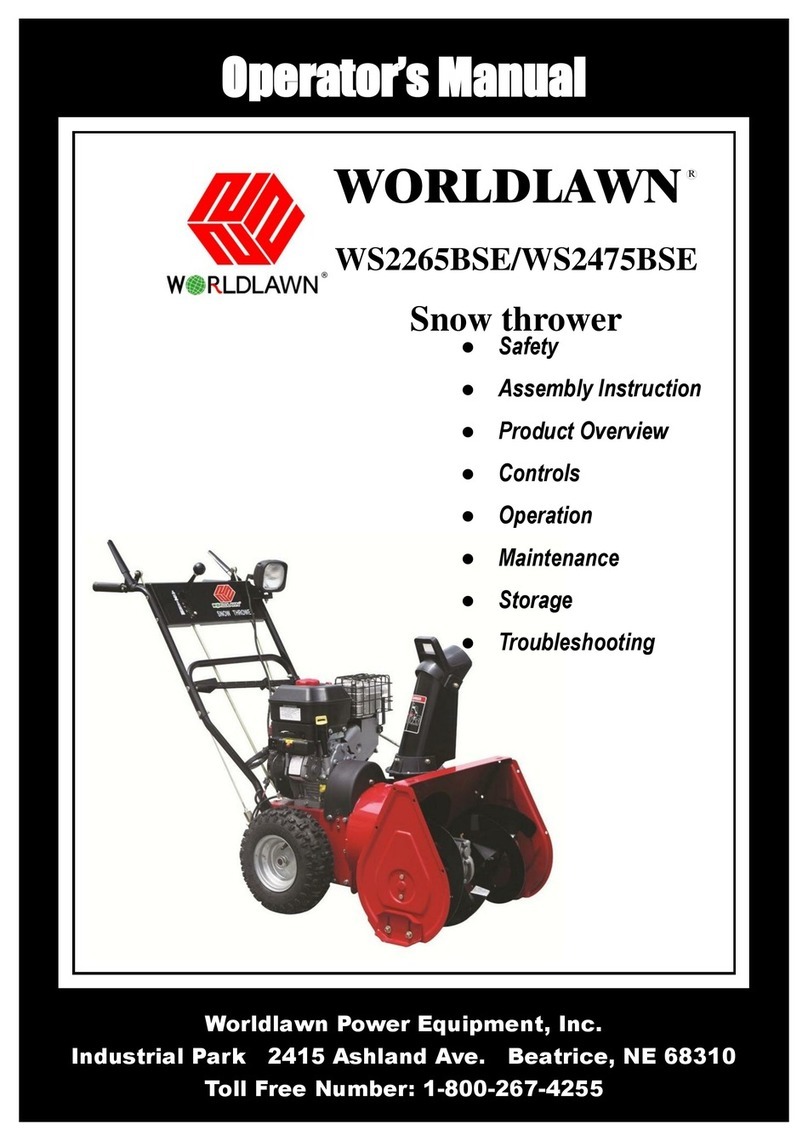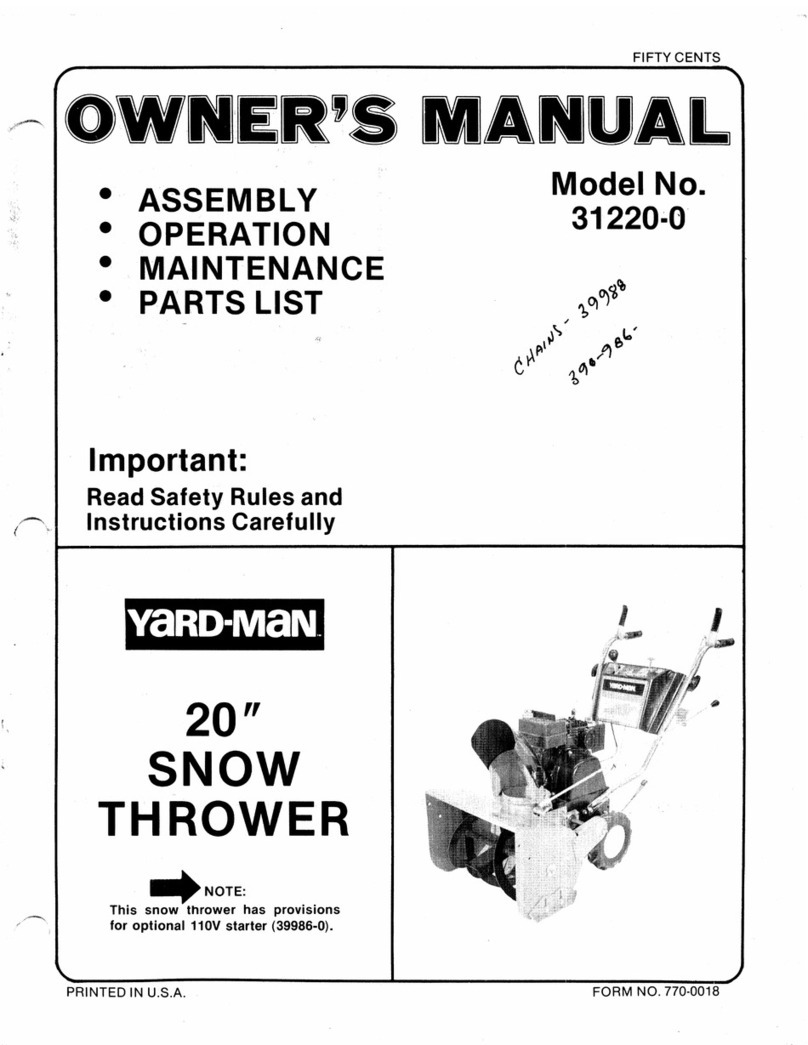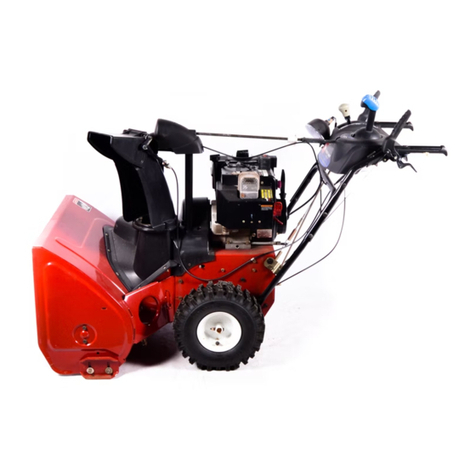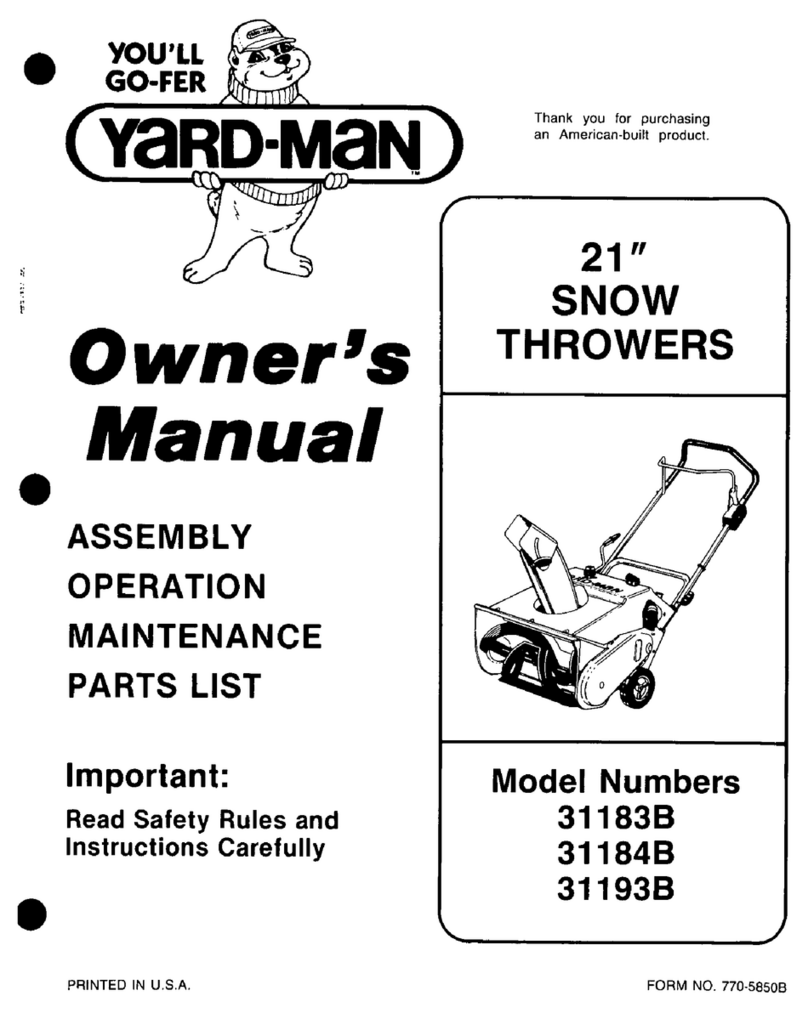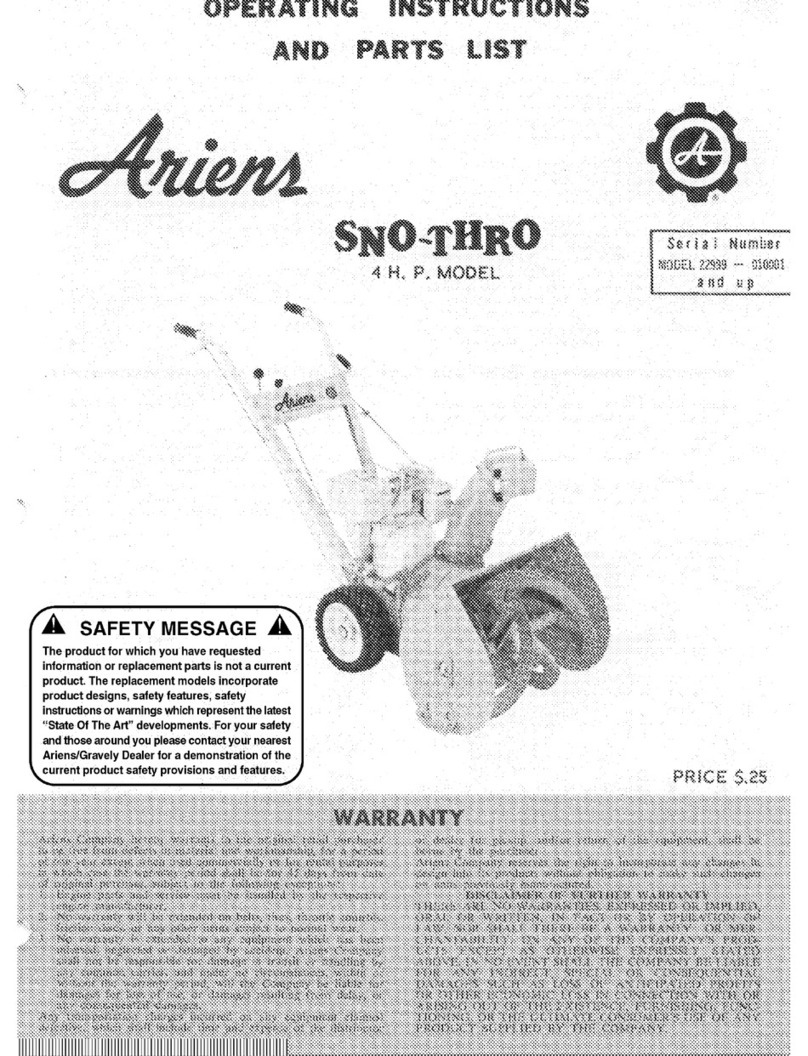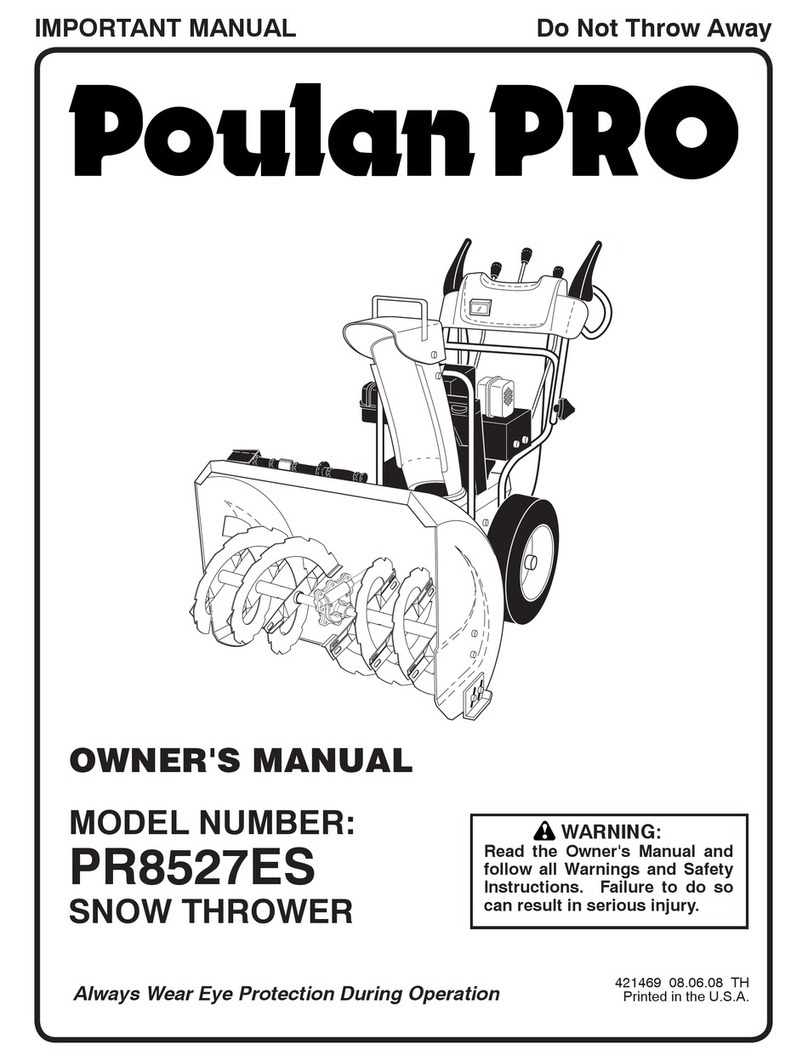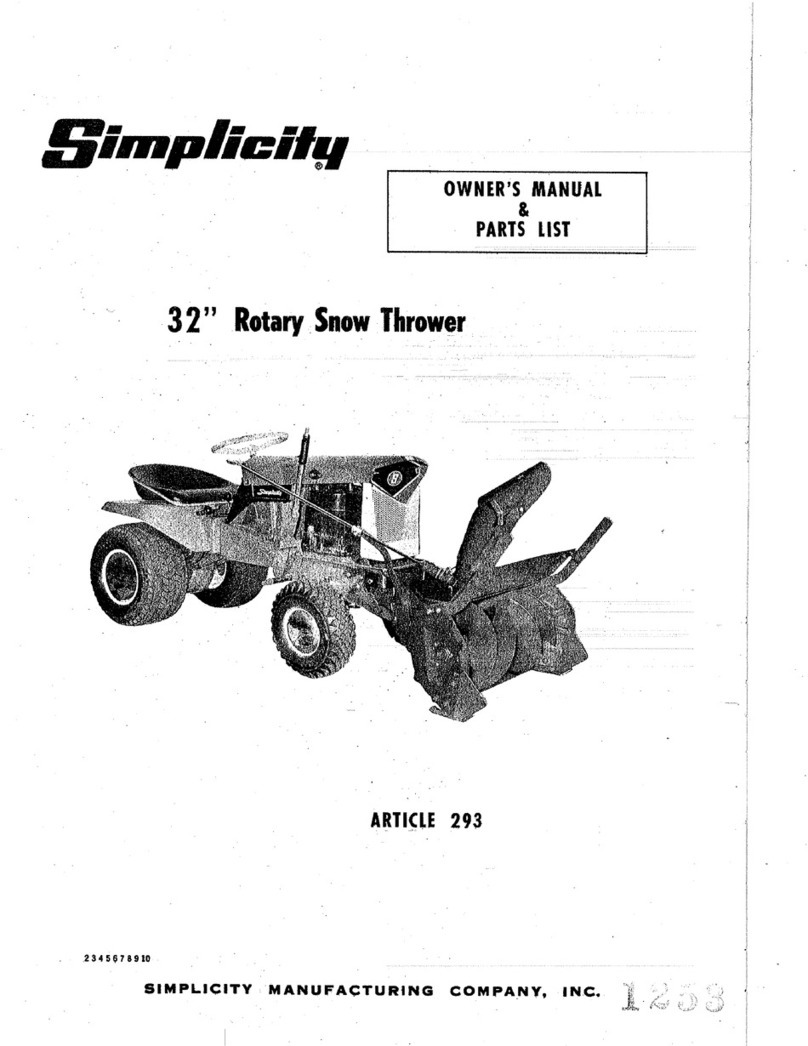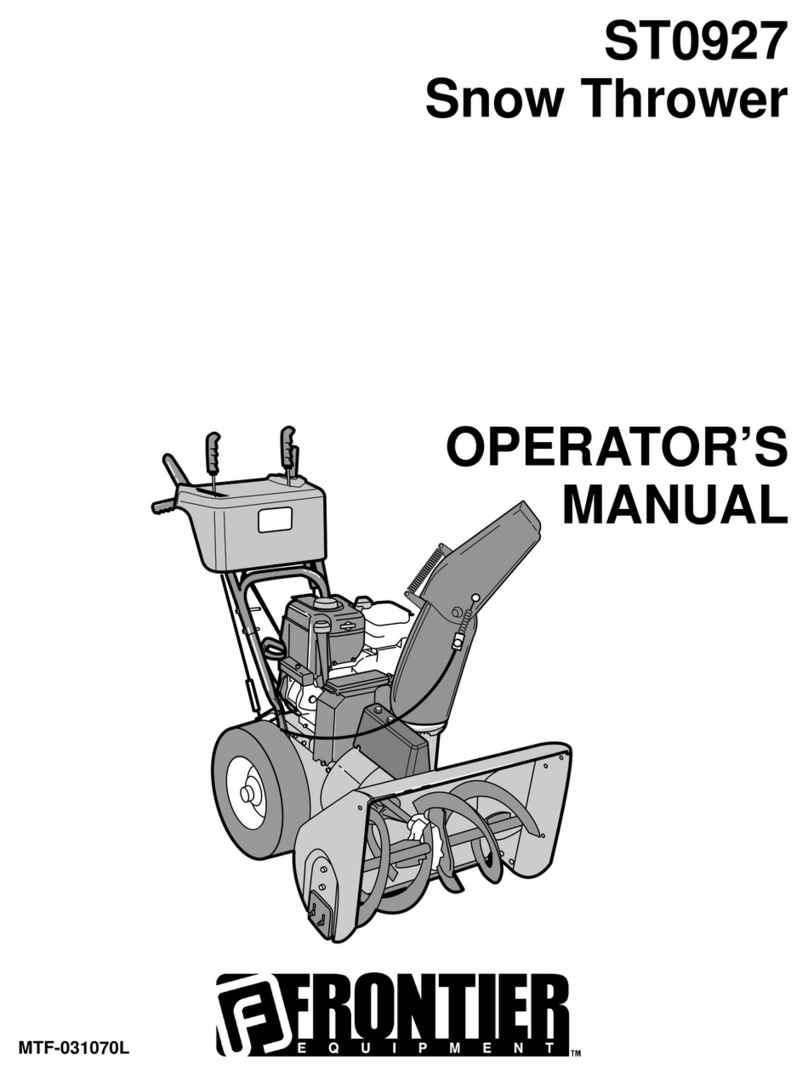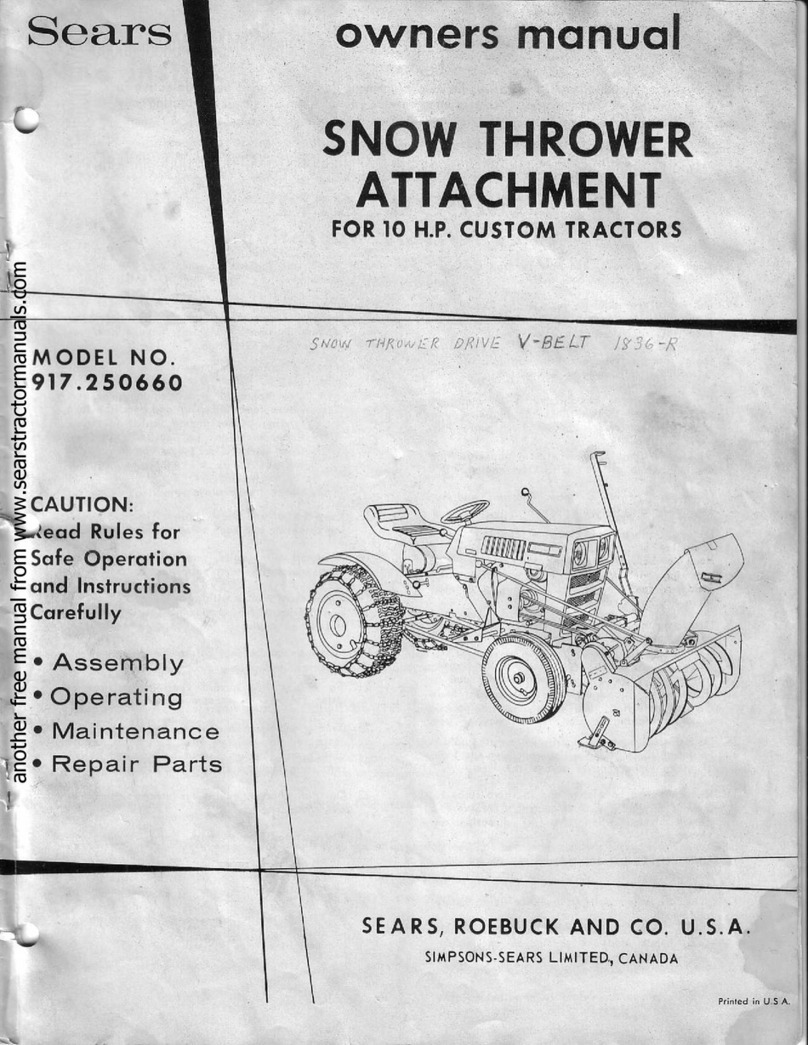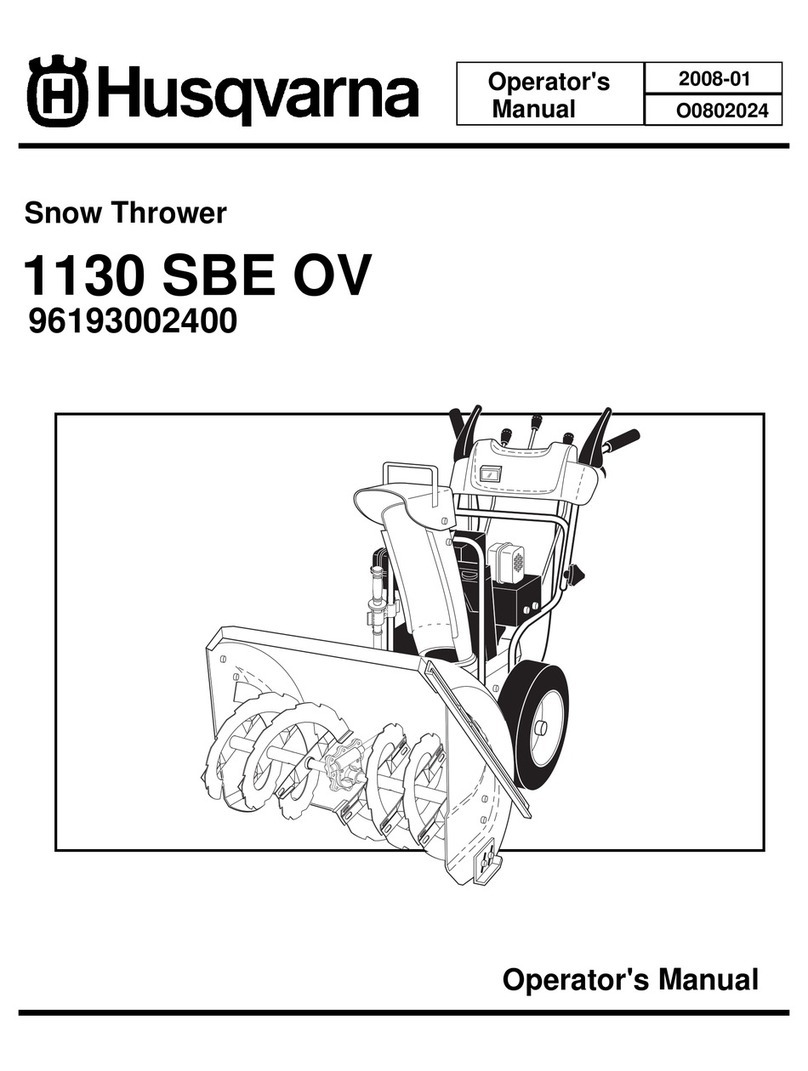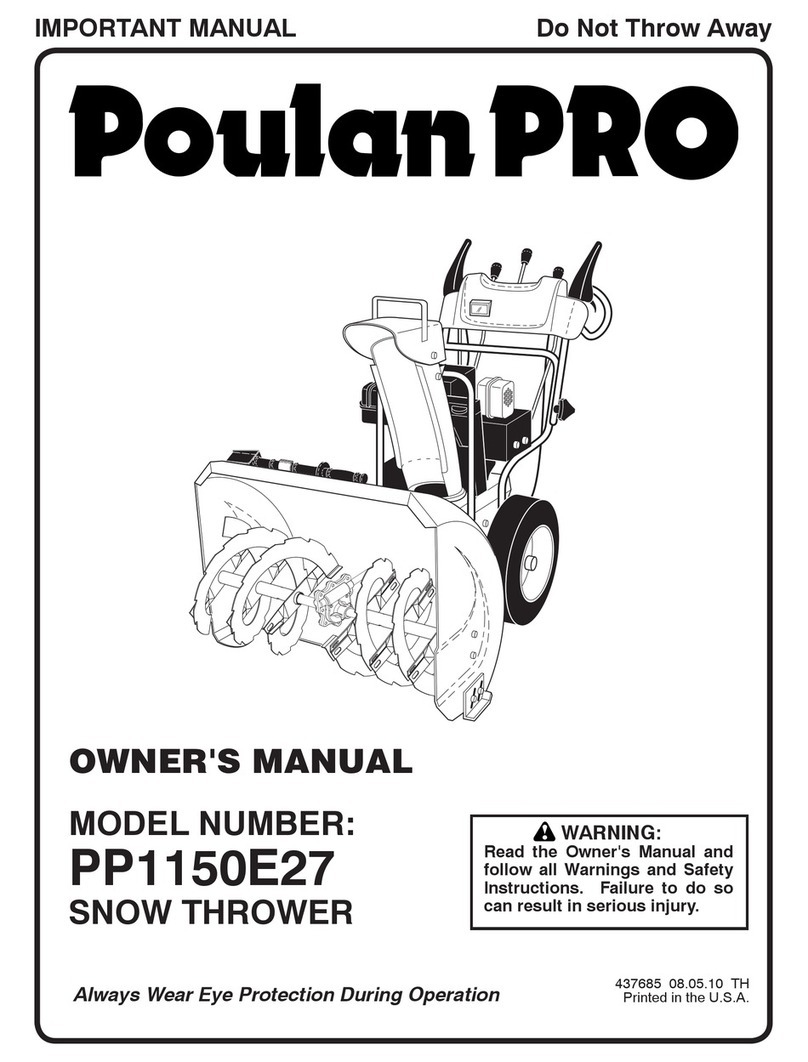Echelon SNOW 34 User manual

1
ECHELON™ SNOW BLOWER
INSTRUCTION MANUAL
SKU: SNOW34
IMPORTANT: PLEASE READ MANUAL BEFORE ASSEMBLY OR USE
Key Technical Parameters
Working
Width
Max. Throwing
Distance
Max Output
Fuel Tank
Cap.
Startup
Mode
Vibration
34in.
50ft
8.3HP/6.2KW
4.0L
Manual
4.559m/s2
BASEMENT BRANDS ● WWW.BASEMENTBRANDS.COM ● CustomerService@BasementBrands.com ● 515-577-0977

2
Hazard Symbols
Rotating Impeller Rotating Parts Toxic Fumes Fire
Hot Surface Fuel Shut-Off Rotating Auger Thrown Objects
Safe Distance Wear eye protection Wear ear protection Wear gloves
Read the Operator’s Manual Shut of engine and remove WARNING:
for operating and safety key before performing Hot surface!
instructions. maintenance or repair work. Do not touch!
Warning Description Auger Danger Decal Chute Danger Decal

3
Safe Operation Procedures
DANGER: This machine was built to be operated
according to the rules for safe operation in this
manual. As with any type of power equipment,
carelessness or error on part of the operator can
result in serious injury or death.
DANGER: This machine is capable of throwing
objects and of amputating hands and feet. Failure
to observe the following safety instructions could
result in serious injury or death.
WARNING: Engine exhaust, some of its
constituents, and certain vehicle components
contain or emit chemicals known to State of
California to cause cancer and birth defects or other
reproductive harm.
WARNING: This symbol points out important
safety instructions which, if not followed, could
endanger the personal safety and/or property of
yourself and others. Read and follow all instructions
in this manual before attempting to operate this
machine. Failure to comply with these instructions
may result in personal injury. When you see this
symbol, HEED ITS WARNING!
WARNING: Restrict the use of this machine to
persons who read, understand and follow the
warnings and instructions in this manual and on the
machine.
Do Not Modify the Engine
To avoid serious injury or death, do not modify the
engine in any way. Never tamper with the factory
setting of an engine governor. Tampering with the
governor setting can lead to a runaway engine and
cause it to operate at unsafe speeds.
Training
•Read, understand, and follow all instructions on
the machine and in the manual(s) before
attempting to assemble and operate this unit.
Keep this manual in a safe place for future
reference and for ordering replacement parts.
•Be familiar with all controls and their proper
operation. Know how to stop the machine and
disengage them quickly.
•Never allow children under 14 years old to
operate this machine. Children 14 years old and
over should read and understand the operation
instructions and safety rules in this manual and
should be trained and supervised byan adult.
•Never allow adults to operate this machine
without proper instruction.
•Thrown objects can cause serious personal
injury. Plan your snow-throwing pattern to avoid
discharge of material toward roads, bystanders
and the like.
•Keep bystanders, pets and children at least 75
feet from the machine while it is in use. Stop the
machine if anyone enters the area.
•Exercise caution to avoid slipping or falling,
especially when operating in reverse.

4
Preparation
1. Thoroughly inspect the area where the machine
is to be used. Remove all doormats, sleds,
boards, wires and other foreign objects that could
be tripped over or thrown bythe auger/impeller.
2. Always wear safety glasses or eye shields to
protect your eyes during operation and while
performing an adjustment or repair. Thrown
objects can ricochet and cause serious injury to
the eyes.
3. Do not operate the machine without wearing
adequate winter garments. Avoid loose fitting
clothing that can get caught in moving parts. Do
not wear jewelry, long scarves or other loose
clothing that could become entangled in moving
parts. Wear footwear that will improve footing
on slippery surfaces.
4. Use a grounded three-wire extension cord and
receptacle for all units with electric start engines.
5. Adjust the collector housing height as necessary
to clear gravel or crushed rock surfaces.
6. Disengage all clutches and shift the machine
into neutral before starting the engine.
7. Never attempt to make any adjustments while
the engine is running, unless specifically
recommended in the operator’s manual.
8. Let the engine and machine adjust to outdoor
temperatures before starting to clear snow.
9. Use extreme care in handing gasoline to avoid
personal injury or property damage. Gasoline is
extremely flammable and the vapors are
explosive. Serious personal injury can occur
when gasoline is spilled on yourself or your
clothes, which could ignite. If any fuel is spilled
on yourself or your clothing, wash your skin and
change clothes immediately.
-Only use an approved gasoline container.
-Extinguish all cigarettes, cigars, pipes and
other sources of ignition.
-Fill the fuel tank outdoors with extreme
care. Never fill the fuel tank indoors.
-Never remove the gas cap or add fuel while
the engine is hot or running.
-Allow the engine to cool at least two
minutes before refueling.
-Never over fill the fuel tank. Fill the tank to
no more than ½ inch below the bottom of
the filler neck to provide space for fuel
expansion.
-Never fill containers inside a vehicle or on a
truck or trailer bed with a plastic liner.
Always place containers on the ground,
away from your vehicle, before filling them.
-When practical, remove the gas-powered
machine from the truck or trailer and refuel
it on the ground. If this is not possible, then
refuel such equipment on a trailer with a
portable container, rather than from a
gasoline dispenser nozzle.
-Keep the nozzle in contact with the rim of
the fuel tank or container opening at all
times, until refueling is complete. Do not
use a nozzle lock-open device.
-Replace gasoline cap and tighten securely.
-If any gasoline is spilled, wipe it off of the
engine and equipment. Move the machine
to another area. Wait 5 minutes before
starting the engine.
10. Allow the machine to cool at least 5 minutes
before storing it.
Operation
•Do not put hands or feet near rotating parts, in
the auger/impeller housing, or in the chute
assembly. Contact with rotating parts can
amputate hands and feet. Stay clear of the
discharge opening at all times.
•After striking a foreign object, stop the engine
(motor), remove the wire from the spark plug,
and disconnect the cord on electric motors.
Thoroughly inspect the snow blower for any
damage, and repair the damage before
restarting and operating the snow blower.
•Stop the engine (motor) whenever you leave
the operating position, before unclogging the
collector/impeller housing or discharge chute,
and when making any repairs, adjustments or
inspections.
•When cleaning, repairing or inspecting the
snow blower, stop the engine and make certain
the collector/impeller and all moving parts have
stopped. Disconnect the spark plug wire and
keep the wire away from the plug to prevent
someone from accidentally starting the engine
•The auger/impeller control lever is a safety
device. Do not bypass its operation. Doing so
makes the machine unsafe and may cause
personal injury.
•The control levers must operate easily in both
directions and automatically return to the
disengaged position when released.
•Never operate the snow blower without proper
guards and other safety protective devices in
place and working.

5
•Never run an engine indoors or in a poorly
ventilated area. Engine exhaust contains
carbon monoxide, an odorless and deadly gas.
•Do not operate machine while under the
influence of alcohol or drugs.
•Exercise extreme caution when operating on or
crossing gravel surfaces. Watch out for hidden
hazards or traffic.
•Exercise caution when changing direction and
while operating on slopes. Do not attempt to
clear steep slopes.
•Plan your snow-throwing pattern to avoid
discharging snow towards windows, walls, cars,
etc., and to avoid possible property damage or
personal injury caused by a ricochet.
•Never direct the discharge toward people or
areas where property damage can occur. Keep
children and others away.
•Do not overload machine capacity by
attempting to clear snow at too fast of a rate.
•Never use this machine without good visibility
or light. Always be sure of your footing and
keep a firm hold on the handles. Do not run with
the machine.
•Disengage power to the auger/impeller when
transporting the machine, or while it is not in use.
•Never operate the machine at high transport
speeds on slippery surfaces. Look down and
behind and use care when backing up. Use
care when reversing
•If the machine should start to vibrate abnormally,
stop the engine, disconnect the spark plug wire,
and ground the wire against the engine. Inspect
it thoroughly for damage. Repair any damage
before starting and operating the machine.
•Disengage all control levers and stop the engine
before you leave the operating position. Wait
until the auger/impeller comes to a complete
stop before unclogging the chute assembly or
making any adjustments or inspections.
•Never put your hand in the discharge or collector
openings. Always use the clean-out tool to
unclog the discharge opening. Do not unclog the
chute assembly while the engine is running. Shut
off the engine and stay behind the handles until
all moving parts have stopped before unclogging
or attempting to unclog thechute.
•Only use attachments and accessories approved
by the manufacturer (e.g. wheel weights, tire
chains, cabs, etc.).
•Never touch a hot engine or muffler.
•If situations occur which are not covered in this
manual, use care and good judgment. Contact
your Authorized Service Dealer for assistance.
Maintenance & Storage
•Never tamper with safety devices. Check their
operation regularly. Refer to the “Maintenance”
and “Adjustment”sections of this manual.
•Disengage all control levers and stop the
engine before cleaning, repairing, or inspecting
the machine. Wait until the auger/impeller come
to a complete stop. Disconnect the spark plug
wire and ground it against the engine to prevent
unintended starting.
•Maintain or replace safety and instruction labels
as necessary.
•Frequently check the machine’s bolts and
screws for proper tightness and to keep the
machine in safe working condition. Visually
inspect the machine for any damage.
•Snow blower shave plates and skid shoes are
subject to wear and damage. For your safety
and protection, frequently check all components
and only replace them with the original
equipment manufacturer’s (OEM) parts. Using
parts which do not meet the original equipment
specifications may lead to improper performance
and compromise safety.
•If you need to change the belts, please contact
the distributor or local agent. Do not change
them by yourself.
•Do not change the engine governor setting or
over-speed the engine.
•Observe proper disposal laws and regulations
for gas, oil, etc. to protect the environment.
•Prior to storing the machine, continue running it
for a few minutes to clear snow from it and to
prevent freeze-up of the auger/impeller.
•Never store the machine or fuel container inside
near an open flame, spark or pilot light such as
a water heater, furnace, clothes dryer etc.
•Always refer to the operator’s manual for proper
instructions on off-season storage.
Clearing a Clogged
Discharge Chute
Important: The most common cause of injury
associated with snow blowers is from hand
contact with rotating rotor blades inside the
discharge chute. Never use your hand to clean
out the discharge chute.
To clear the chute:
•SHUT THE ENGINE OFF!
•Wait 10 seconds to be sure the rotor blades
have stopped rotating.
•Always use a clean-out tool, not your hands.

6
Package Contents
1. Armrest
2. Chute (attached with instructions and fittings)
Controls & Features
1. Drive control 7. Clean-out tool
2. Auger control 8. Dipstick
3. Chute direction control 9. Skid shoes
4. Speed control 10. Auger
5. Gas cap 11. Chute control
6. Chute assembly
Residual Risks
Even when the machine is used as prescribed it is
not possible to eliminate all residual risk factors.
The following hazards may arise in connection
with the machine’s construction and design:
1. Damage to lungs if an effective dust mask is
not worn.
2. Damage to hearing if effective hearing
protection is not worn.
3. Damages to health resulting from vibration
emission if the power tool is being used over a
longer period of time or is not adequately
managed and properly maintained.
This machine produces an electromagnetic field
during operation. This field may under some
circumstances interfere with active or passive
medical implants. To reduce the risk of serious or
fatal injury, we recommend persons with medical
implants consult their physician and implant
manufacturer before using this machine.
The declared vibration total value has been
measured in accordance with a standard test
method and may be used for comparing one tool
with another. This value may also be used in a
preliminary assessment of exposure.
The vibration emission during actual use of the
machine can differ from the declared total value
depending on the ways in which it is used.
It is necessary to identify safety measures based
on an estimation of exposure in actual operation
conditions (taking account of all parts of the
operating cycle, such as the times when the tool is
switched off and when it is running idle in addition
to the trigger time).
Noise (tested according to 2000/14/EC, amended
by 2005/88/EC):
Guaranteed Sound power values:
LwA: 106 dB(A), LpA= 91.8 dB(A), K= 3 dB(A)
Vibration (tested according to ISO 8437:
1989+A1): ah= 4.559 m/s2 K= 1.5 m/s

7
Assembly
1. Unscrew the bolt and take off the upper bracket.
2. Mount the armrest: Unscrew the nut and put
four bores in order on the upper armrest. Insert
the bolt and screw it with a nut.
3. Mount the connecting rod: Pull out the pinchcock
and pin bearing, then drill through a bore on the
connecting rod with a pin bearing. Insert the
pinchcock in the pin bearing, and screw the other
side on the connecting rod with a nut.
4. Mount the rocker: Plug the rocker inside of
gimbal from the armrest panel, so that the
rocker bore aims at the bore on the gimbal.
Then, insert the pinchcock.
5. Mount the chute: Unscrew the bolt on the chute,
place it on the chute seat, align the fixed block
with a bore, and screw thefixed block with a bolt.

8
Operating Controls
WARNING: Read, understand, and follow all
instructions and warnings on the machine and
in this manual before operating.
SHIFT LEVER
The shift lever is located between the lower handles.
Place the shift lever into any of seven positions to
control the direction of travel and ground speed.
Forward
There are five forward (F) speeds. Position one (1) is
the slowest and position five (5) is the fastest.
Reverse
There are two reverse (R) speeds. Position one (1) is
the slower speed and two (2) is the faster speed.
Primer
Depressing the primer forces fuel directly into the
engine’s carburetor to help with starting the machine
in cold weather.
CHOKE CONTROL
The choke control is found on the rear of the engine
and is activated by rotating the knob clockwise.
Activating the choke control closes the choke plate
on the carburetor and helps start the engine.
THROTTLE CONTROL
The throttle control is located on the
engine. It regulates the speed of the
engine and will shut off the engine
when pushed down completely.
AUGER CONTROL
The auger control is located on the left handle.
Squeeze the control grip against the handle to
engage the augers and start throwing snow. Release
the control grip to stop.
DRIVE CONTROL
The drive control is located on the right handle.
Squeeze the control grip against the handle to engage
the wheel drive. Release the grip to disengage it.

9
CHUTE DIRECTIONAL CONTROL
The chute directional control is located on the panel of
the snow blower. To change the direction in which
snow is thrown, turn the control as follows:
•Crank it clockwise to discharge to the right.
•Crank counterclockwise to discharge to the left.
A – Discharge Chute Rotation (Left/Right)
1. Press the chute rotation switch to the UP
position and hold it there to rotate the chute
to the left.
2. Press the switch to the DOWN position and
hold it to rotate the chute to the right.
3. After reaching the desired position,
release the switch to the CENTER position
to turn it off.
B – Chute Deflector (Up/Down)
1. Press the chute deflector switch to the UP
position and hold it there to provide a higher
stream of snow and for a greater distance.
2. Press the switch to the DOWN position and
hold it there to provide a lower stream and for
less distance.
3. After reaching the desired position,
release the switch to the CENTER
position to turn it off.
CLEAN-OUT TOOL
WARNING: Never use your hands to clear a
clogged chute assembly. Shut off the engine and
stay behind its handles until all moving parts have
stopped before you unclog or attempt to unclog
the chute.
The chute clean-out tool is fastened to the top of the
auger housing with a mounting clip. The tool is
designed to clear a clogged chute assembly.
NOTE: This item (along with the electric starter’s
extension cord) is fastened with a cable tie to the rear
of the auger housing at the factory. Cut the cable tie
before operating the snow blower.
SKID SHOES
Position the skid shoes based on surface conditions.
Adjust them upward for hard-packed snow. Adjust
them downward when operating on gravel or crushed
rock surfaces.
RECOIL STARTER HANDLE
This handle is used to start the engine.
AUGERS
When engaged, the augers rotate and draw snow into
the auger housing.
CHUTE ASSEMBLY
Snow drawn into the auger housing is discharged out
the chute assembly.
GAS CAP
Unscrew the gas cap to add gasoline to the fuel tank.
OIL FILL
Engine oil level can be checked and oil added through
the oil fill.

10
Before Starting the Engine
Do not start the engine until it has been filled with
oil. Starting the engine without oil can cause
serious damage to the machine.
1. Place the machine on a level floor.
2. Loosen the dipstick and read the oil level. The
oil level shall be between the marks “HIGH”
and “LOW.”
3. If necessary, fill the machine with oil up to the
FULL mark.
Use good quality oil marked API service SF, SG or
SH. Use SAE 5W30 oil. Use SAE OW30 oil for
temperatures under -18℃. Do not use SAE 10W40.
Gasoline
WARNING: Use extreme care when handling
gasoline as it is extremely flammable and the
vapors are explosive. Never fuel the machine
indoors or while the engine is hot or running.
Extinguish cigarettes, cigars, pipes and other
sources of ignition.
•Store gasoline in a clean, approved container
and keep the cap in place on the container.
•Make sure that the container from which you
pour the gasoline is clean and free from rust or
other foreign particles.
NOTE: A plastic dust cap may be found inside the
fuel fill opening. Remove and discard it, if present.
•Always fill the fuel tank outdoors and use a
funnel or spout to prevent spilling.
•Fill the fuel tank with clean, unleaded gasoline.
•Never fill the fuel tank completely. Fill the tank
to within ½ inch from the top to provide space
for expansion of fuel.
•Make sure to wipe off any spilled fuel before
starting the engine.
Starting the Engine
1. Attach the spark plug wire to the spark plug. Make
certain the metal loop on the end of the spark plug
wire (inside the rubber boot) is fastened securely
over the metal tip on the spark plug.
2. Ensure that both the auger control and drive
control are in the disengaged (released) position.
3. Move the throttle control up to FAST position.
Insert ignition key into slot. Make sure it snaps
into place. Do not attempt to turn the key.
NOTE: The engine cannot start without the key
fully inserted into the ignition switch.
Recoil Starter
1. Rotate the choke control to FULL choke
position (cold engine start).
NOTE: If the engine is already warm, put the
choke control in the OFF position instead of
FULL.
2. Push the primer two or three times for a cold
engine start, making sure to cover the vent hole
in the center of the primer when pushing it.
NOTE: DO NOT use the primer to restart a
warm engine after a short shutdown.
NOTE: Additional priming maybe necessary if
the temperature is below 15° Fahrenheit.
3. Grasp the recoil starter handle and slowly pull
the rope out. When it becomes slightly harder to
pull the rope, slowly allow the rope to recoil.
4. Pull the starter handle with a firm, rapid stroke.
Do not release the handle and allow it to snap
back. Keep a firm hold on the starter handle
and allow it to slowly recoil.
5. As the engine warms, slowly rotate the choke
control to the OFF position. If the engine falters,
quickly rotate the choke control back to the
FULL position, and then slowly into the OFF
position again.
NOTE: Allow the engine to warm up for a few
minutes after starting. The engine will not
develop full power until it reaches operating
temperatures.

11
To Engage Drive
1. With the throttle control in the FAST (rabbit)
position, move the shift lever into one of the
five forward (F) positions or two reverse (R)
positions. Select a speed appropriate for the
conditions and a pace at which you are
comfortable.
NOTE: When selecting a Drive Speed, use the
slower speeds until you are comfortable and
familiar with the operation of the snow blower.
2. Squeeze the auger control against the handle
and the auger will turn. Release it to stop.
3. Squeeze the drive control against the handle
and snow blower will move. Release it to stop.
IMPORTANT: NEVER reposition the shift
lever (change speeds or direction of travel)
without first releasing the drive control and
bringing the snow blower to a complete
stop. Doing so will result in premature wear
to the snow blower’s drive system.
Engine Speed
WARNING: To avoid serious injury or
death, DO NOT modify the engine in any way.
Tampering with the governor setting can cause
the engine and equipment to operate at unsafe
speeds. NEVER tamper with factory setting of
the engine governor. Running the engine faster
than the speed set at the factory is dangerous.
Stopping the Engine
Run the engine for a few minutes before stopping it to
help get rid of any moisture on the engine. To help
prevent possible starter freeze-up, proceed as follows:
Recoil Starter
1. With the engine still running, pull the starter
rope with a rapid, continuous full arm stroke
three or four times. Pulling the starter rope will
produce a loud clattering sound, which is not
harmful to engine.
2. Move the throttle control to the STOP position.
3. Remove the ignition key and store it in a safe
place.
4. Wipe all snow and moisture from the area
around the engine as well as the area in and
around the drive control.
Service & Adjustment
Chute Assembly Adjustment
The distance snow is thrown can be adjusted by
changing the angle of the chute assembly.
1. Stop the engine by removing the ignition key
and loosening the plastic wing knob found
on the leftside of the chute assembly.
2. Pivot the chute upward or downward before
retightening the wing knob.
Chute Bracket Adjustment
If the spiral at the bottom of the chute directional
control is not fully engaging with the chute
assembly, the chute bracket can be adjusted using
the following procedures:
1. Loosen the two nuts which secure the
chute bracket and reposition the bracket.
2. Retighten the nuts.
Carburetor
If you suspect your carburetor needs adjusted, see
an Authorized Parts and Repair Center. Engine
performance should not be affected at altitudes up
to 7,000 feet. For operation at higher elevations,
contact an Authorized Parts and Repair Center.

12
Control Wires
The control wires must be adjusted after a long time
of use, or when the belts are adjusted or replaced.
1. Lift the snow blower forward and rest in on the
auger housing.
2. Push the wire through the spring so that the
threaded part is exposed.
3. Hold the threaded part and adjust the nut or
until the correct setting is obtained.
4. Pull the wire through the spring again.
5. Hook the wire into the upper part of the clutch
lever, using the same adjustment for both sides.
Tire Pressure
Before operating the machine, check its tire
pressure and reduce the pressure to between 15 psi
and 20 psi. If the tire pressure is not equal in both
tires, the unit may pull to one side or the other.
Chute Clean-Out Tool
The chute clean-out tool is conveniently fastened to
the rear of the auger housing with a mounting clip.
Should snow and ice become lodged in the chute
assembly during operation, proceed as follows to
safely clean the chute assembly and chute opening:
1. Release both the Auger and the Drive Control.
2. Stop the engine by removing the ignition key.
3. Remove the clean-out tool from the clip which
secures it to the rear of the auger housing.
WARNING: The muffler, engine and
surrounding areas become hot and can
cause a burn. Do not touch.
4. Use the shovel-shaped end of the clean-out tool
to dislodge and scoop any snow and ice which
has formed in and near thechute assembly.
5. Refasten the clean-out tool to the mounting clip
on the rear of the auger housing, reinsert the
ignition key and start the engine.
6. While standing behind the snow blower, engage
the auger control for a few seconds to clear any
remaining snow and ice from the chute assembly.
Skid Shoe Adjustment
The space between the machine’s skid shoes and
the ground can be adjusted.
•For close snow removal on a smooth
surface, raise the skid shoes higher on the
auger housing.
•Use a middle or lower position when the
area to be cleared is uneven, such as a
gravel driveway.
To adjust the skid shoes:
1. Loosen the four hex nuts (two on each
side) and carriage bolts.
2. Move the skid shoes to the desired
position. Ensure that the entire bottom
surface of the skid shoes are against the
ground to avoid uneven wear.
3. Retighten the nuts and bolts securely.
Shave Plate and Skid Shoes
The shave plate and skid shoes on the bottom of the
snow blower are subject to wear. They should be
checked periodicallyand replaced when necessary.
To remove shave plate:
1. Remove the carriage bolts and hex nuts
which attach it to the snow blower housing.
2. Reassemble the new shave plate, making
sure the heads of the carriage bolts are
inside the housing. Tighten them securely.
To remove skid shoes:
1. Remove the four carriage bolts and hex
flange nuts that secure them to the machine.
2. Reassemble new skid shoes with the four
carriage bolts and hex flange nuts (two on
each side).

13
Lubrication
WARNING: Before lubricating, repairing,
or inspecting the machine, disengage all of the
controls and stop the engine. Wait until all
moving parts have come to a complete stop.
Wheels
At least once a season, remove both wheels. Clean
and coat the axles with a multipurpose automotive
grease before reinstalling the wheels.
Chute Directional Control
Once a season, the joystick should be lubricated
with petroleum jelly, linseed oil, mineral oil, paraffin
wax or 3-in-1 oil.
Gear Shaft
The gear (hex) shaft should be lubricated at least
once a season or after every 25 hours of operation.
1. Remove the lower frame cover by removing the
two screws which secure it.
2. Apply a light coating
of all-weather
multipurpose grease
to the hex shaft.
IMPORTANT: Avoid
spilling oil on the
rubber friction wheel
and aluminum drive
plate.
Gear Case
The auger gear case has been filled with grease and
sealed at the factory. If it is disassembled for any
reason, lubricate it with two ounces of new grease.
NOTE: Do not over fill the gear case. Damage to
the seals could result. Be sure the vent plug is free
of grease in order to relieve pressure.
Auger Shaft
At least once a season,
remove the shear pins on
the auger shaft. Spray
lubricant inside the shaft,
around the spacers, and
on the flange bearings
found at either end of the
shaft.
Maintenance
Checking the Engine Oil
1. Be sure that the engine is upright and level.
2. Unscrew the oil fill cap from the oil filler tube
and wipe dipstick clean.
3. Screw the oil cap back into the oil filler tube
and tighten it securely.
4. Unscrew and remove the oil fill cap from the
oil filler tube.
5. Note the oil level.
If the oil reading
on the dipstick is
below the “LOW”
mark, slowly add
oil to reach the
“HIGH” level.
6. Screw the oil fill cap back into the oil filler
tube and tighten it securely.
7. Wipe away any spilled oil.
Changing Engine Oil
To avoid engine damage, it is important to:
•Check the oil level before each use and after
everyfive hours of operation.
•Change the oil after the first two hours of use, and
after every 25 hours of operation thereafter.
When checking and changing the oil, the engine
should still be warm but not hot from recent use.
To change the oil, use the following procedures:
1. Locate the oil drain plug.
2. Make certain that the gas cap is on and
tightened securely.
3. Clean the area around the oil drain plug.
4. Place an approved recyclable oil container
under the oil drain plug.
5. Remove the oil drain plug and drain the oil.
Note: Dispose of any used oil at a proper
collection center.
6. Re-install the oil drain plug and tighten it
securely.
7. Refill the engine with recommended oil.
The engine’s oil capacity is 26 oz.
8. Wipe away any spilled oil.

14
Checking the Spark Plug
Check the spark plug annually, or after every 100
hours of use.
1. Clean the area around the spark plug.
2. Remove and inspect the spark plug.
3. Replace the spark plug if its porcelain is
cracked or if its electrodes are pitted, burned
orfouled with deposits.
4. Check the electrode gap with a feeler gauge
and set the gap to .030 inches (0.76mm) if
necessary.
5. Reinstall thespark plug and tighten it securely.
NOTE: A resistor spark plug must be used for
replacement. Contact an Authorized Parts and
Repair Center for a replacementspark plug.
Off-Season Storage
Preparing Engine
WARNING: Never store the snow blower with
fuel in its tank indoors, or in poorly ventilated
areas where the fuel fumes may reach an open
flame, spark or pilot light.
NOTE: It is important to prevent gum deposits from
forming in essential fuel system parts of the engine,
such as the carburetor, fuel filter, fuel hose or tank,
during storage.
CAUTION: Alcohol blended fuels (called gasohol),
ethanol or methanol can attract moisture which
leads to separation and formation of acids during
storage. Acidic gas can damage the fuel system of
an engine while in storage.
To avoid engine problems, the fuel system should
be emptied before storage for 30 days or longer.
Follow these instructions to prepare your snow
blower for storage:
1. Remove all gasoline from the carburetor
and fuel tank to prevent gum deposits from
forming on these and damaging the engine.
WARNING: Drain fuel into an
approved container outdoors, away from
any open flame. Be certain the engine is
cool. Do not smoke. Fuel left in an engine
during warm weather may deteriorate and
cause serious starting problems.
2. Run the engine until the fuel tank is empty
and it stops due to a lack of fuel.
3. Drain the carburetor by pressing upward on
the bowl drain (located below the
carburetor cover).
WARNING: Do not drain the
carburetor when using fuel stabilizer.
Never use engine or carburetor cleaning
products in the fuel tank or permanent
damage may occur.
NOTE: Fuel stabilizer (such as STA-BIL) is
an acceptable alternative in minimizing the
formation of fuel gum deposits during
storage. Add such stabilizers to gasoline in
a fuel tank or storage container. Always
follow the mix ratio found on the stabilizer
container. Run the engine at least 10
minutes after adding stabilizer to allow it to
reach the carburetor.
4. Remove the spark plug and pour 1 ounce
of engine oil through the spark hole and
into the cylinder.
5. Cover the spark plug hole with a rag and
crank the engine several times to distribute
the oil.
6. Replace the spark plug.
Preparing the Snow Blower for Storage
1. When storing the snow blower in an
unventilated or metal storage shed, be sure
to rustproof the machine. Coat the equipment
and especially any chains, springs, bearings
and cables, byusing a light oil or silicone.
2. Remove all dirt from the exterior of the
engine and equipment.
3. Follow the lubrication recommendations in
the “Maintenance”section of this manual.
4. Store the equipment in a clean dry area.
Table of contents
Other Echelon Snow Blower manuals
Popular Snow Blower manuals by other brands
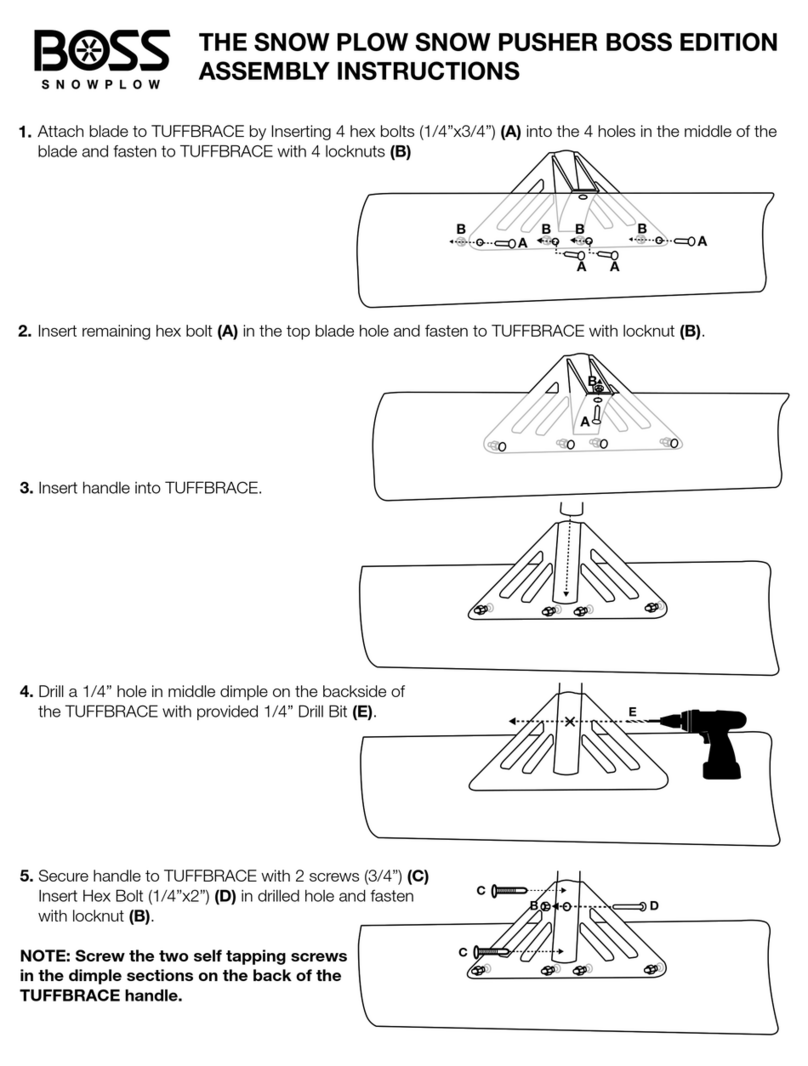
Boss Snowplow
Boss Snowplow THE SNOW PLOW SNOW PUSHER Assembly instructions

White Outdoor
White Outdoor 235 Operator's manual

Poulan Pro
Poulan Pro 199342 owner's manual
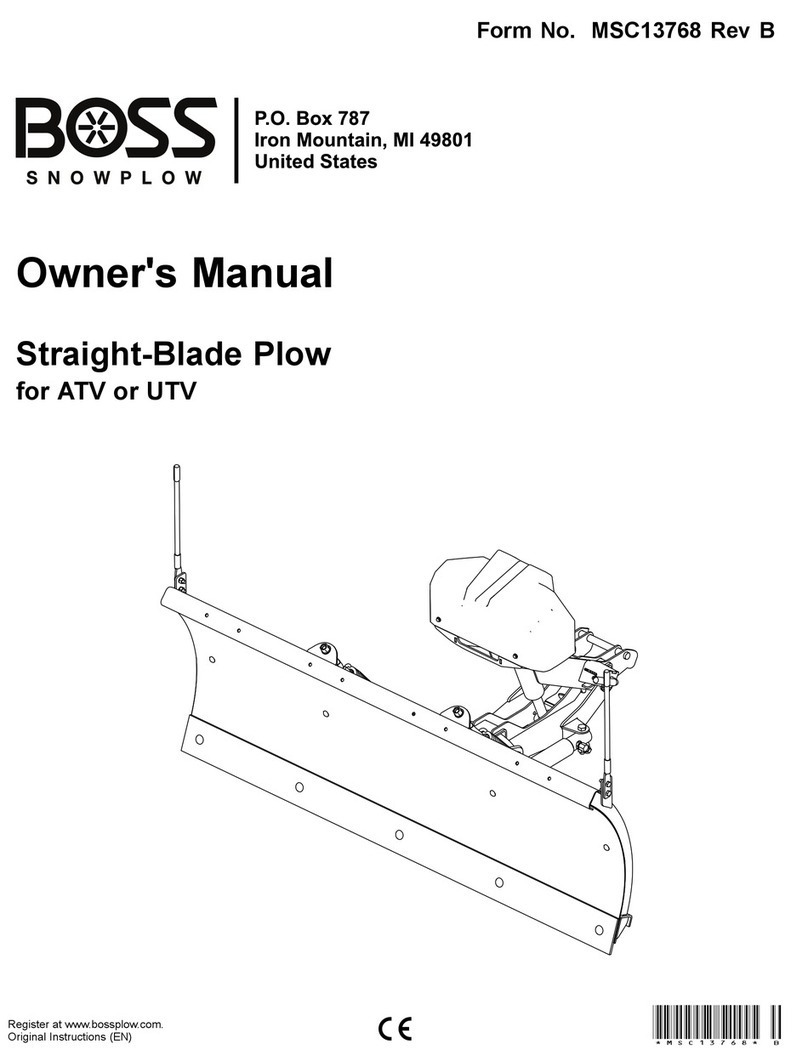
Boss Snowplow
Boss Snowplow ATV Series owner's manual
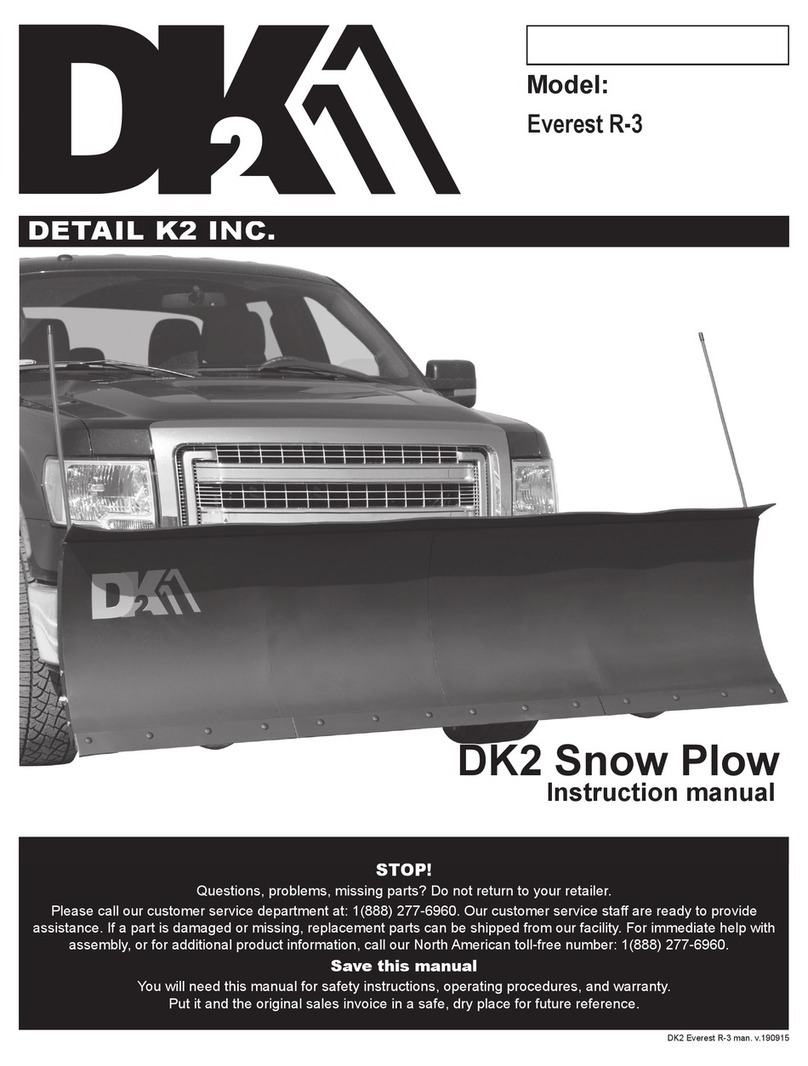
DK2
DK2 Everest R-3 instruction manual

Husqvarna
Husqvarna 15530SB-LS Operator's manual

